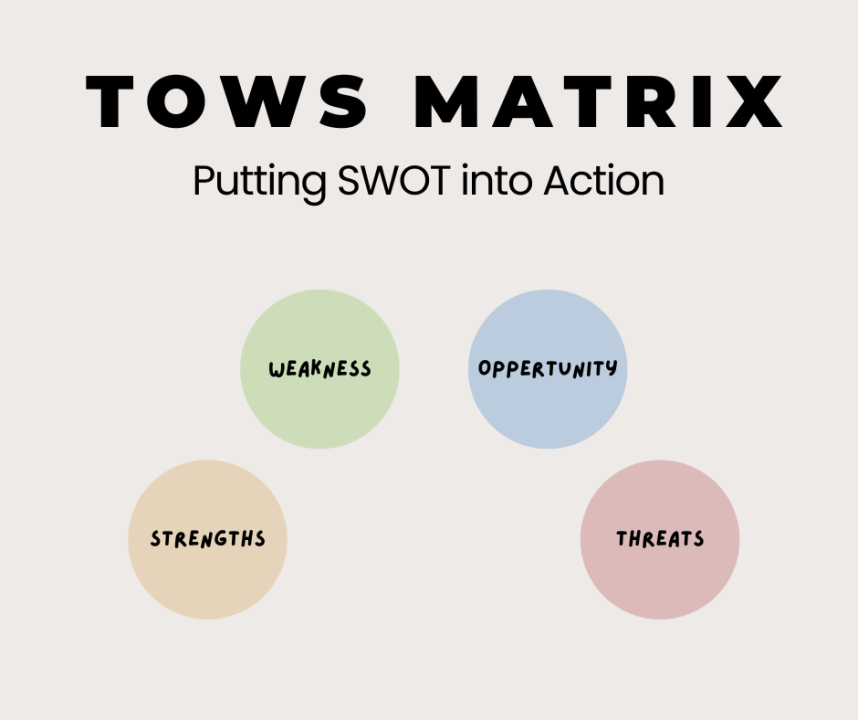
TOWS Matrix: Putting SWOT into action
Abhisek Panda
Startup, Business Strategy, Partnerships & Growth | Real Estate | Ex Vodafone, Tata Tele, Vedanta | Entrepreneur | Blogger
In the ever-evolving landscape of business strategy, tools like the TOWS Matrix serve as guiding stars, illuminating the path towards informed decision-making and strategic planning. Derived from the SWOT analysis, the TOWS matrix takes a proactive stance, emphasizing proactive strategies over reactive responses. But what exactly is the TOWS Matrix, and why is it crucial in today's competitive environment?
Understanding the TOWS Matrix
The TOWS Matrix, an acronym for Threats-Opportunities-Weaknesses-Strengths, is a strategic management tool designed to assess internal and external factors affecting an organization's performance. It was developed by?Heinz Weihrich?in 1999 and it involves a comprehensive analysis of both the internal strengths and weaknesses as well as the external opportunities and threats faced by the organization.
The TOWS Matrix serves as a cornerstone in strategic planning, aiding organizations in making informed decisions by aligning internal capabilities with external opportunities while mitigating potential threats. Unlike traditional SWOT analysis, which often focuses solely on internal factors, the TOWS Matrix provides a more holistic view of the strategic landscape.
A TOWS matrix analysis is similar to a SWOT analysis but focuses more on external factors first—identifying elements that could either benefit or harm your business. It then lines up these external factors with your company’s strengths and weaknesses. This approach helps you make the best use of your abilities, address your shortcomings, seize opportunities, and tackle threats. It's like connecting external happenings to your internal business operations through a structured evaluation. It involves a systematic evaluation of:
Uniting Strengths and Opportunities
One of the key principles of the TOWS matrix is the synergy between strengths and opportunities. By aligning internal strengths with external opportunities, organizations can maximize their competitive advantage and drive sustainable growth.
Leveraging Strengths to Seize Opportunities
Let's now explore how organizations can leverage their strengths to capitalize on emerging opportunities:
Confronting Weaknesses and Threats
In addition to exploiting strengths and opportunities, the TOWS matrix emphasizes the importance of addressing weaknesses and threats to mitigate risks and safeguard organizational performance.
Mitigating Weaknesses to Counter Threats
Let's explore how organizations can mitigate their weaknesses to counter external threats effectively:
How TOWS Work
领英推荐
Strategies Under TOWS Matrix
Mini-Mini Strategies (WT):
These strategies focus on handling both outside dangers and internal shortcomings. In extreme situations, this could mean shutting down the business or combining it with another company. However, it's better to concentrate on using strengths to seize opportunities, using strengths to tackle threats, and improving weaknesses by seizing opportunities rather than relying heavily on strategies that focus only on minimizing weaknesses.
Mini-Maxi Strategies (WO):
These strategies take advantage of what's happening in the market to improve weak points inside the company. For instance, if producing goods is too expensive and exporting is difficult, buying a company in London that has up-to-date factories and can easily send products across Europe could solve these problems and also help the company expand.
Maxi-Maxi Strategies (SO):
These strategies help you use what you're good at to take advantage of market opportunities. For instance, by using your well-known brand and your ability to produce many products, you can start selling new items. This allows you to satisfy customer needs that others aren't and stay ahead of your competitors.
Maxi-Mini Strategies (ST):
These strategies play to your strengths to handle market challenges. For example, you can use your ample budget and strong brand loyalty to respond to a competitor’s new product by launching your own innovative versions.
How Does it Differ from SWOT?
While both the TOWS matrix and SWOT analysis share similarities, they diverge in crucial ways:
FAQs: Demystifying the TOWS Matrix
Q: Is the TOWS matrix suitable for all types of organizations? A: Yes, the TOWS matrix can be applied to various industries and organizational sizes, providing a flexible framework for strategic planning and decision-making.
Q: How often should organizations revisit their TOWS matrix? A: It's recommended that organizations revisit their TOWS matrix periodically, especially in response to significant internal or external changes, to ensure its relevance and effectiveness in guiding strategic initiatives.
Q: Can the TOWS matrix be used in conjunction with other strategic planning tools? A: Absolutely! The TOWS matrix can complement other strategic planning tools such as PESTLE analysis or Porter's Five Forces, providing a holistic view of the business environment and informing comprehensive strategic decisions.
Conclusion
In conclusion, the TOWS matrix represents a paradigm shift in strategic planning, offering a dynamic framework for organizations to navigate complex business landscapes with confidence and clarity. By uniting strengths with opportunities and addressing weaknesses and threats head-on, the TOWS matrix empowers organizations to unlock their full potential and achieve sustainable growth in an ever-evolving marketplace. So, what are you waiting for? Embrace the TOWS matrix and embark on a journey towards strategic excellence today!
Read more at https://abhisekpanda.com/